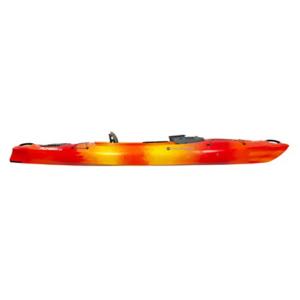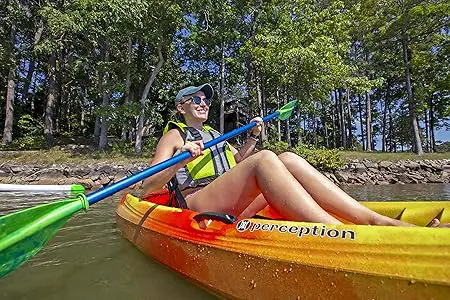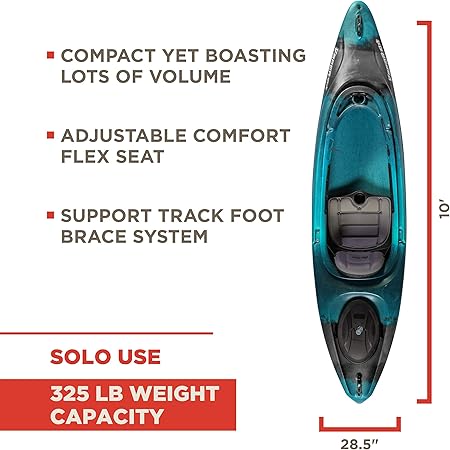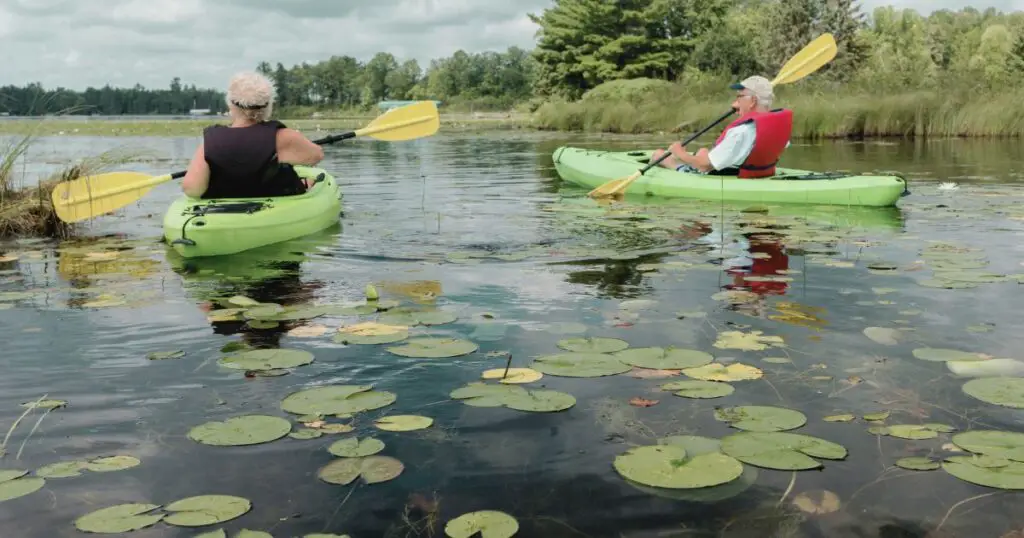As an Amazon affiliate, I may earn from qualifying purchases. Please read our Disclaimer and Privacy Policy.
The best kayaks for seniors should provide good stability, comfort, and durability. When you’re looking for a good kayak, look for ones with large, open cockpits or sit-on-top kayaks.
This makes it easier to get in and out of the kayak.
A good kayak should be buoyant enough to support your weight along with any gear you may have.
Of course, you can’t forget the safety features! These include life vest storage, grab handles, watertight bulkheads and hatches, and bright colors for visibility in the water.
Kayaking is a fantastic option for senior citizens to enjoy the great outdoors, stay active, and experience the benefits of kayaking in their golden years.
With the right kayak, older adults can engage in this low-impact physical activity safely and comfortably.
Here, we’ll explore five of the best lightweight kayaks, ideal for senior citizens who are recreational kayaking for the first time or have extensive experience.
In this post, I’m going to share five great kayaks perfect for seniors. I’m sure there are many different types of kayaks out there that would be perfectly fine, but this should give you a good idea of what to look for when you’re out shopping.
DISCLAIMER
Just a quick heads-up: the info in this blog post is meant to help and inform, but it might not be perfect for everyone. Kayaking can be risky, so please check with your doctor before starting and get some professional training if you’re new to it.
We’re not endorsing any specific kayaks—everyone’s needs are different. Always wear your safety gear and follow local rules. We’re not responsible for any issues that come up from using this info. Paddle safely and enjoy the water!
Physical Health Benefits of Kayaking
Kayaking offers a range of physical and mental health benefits, and with the right precautions, it can be a safe and enjoyable activity.
Low-Impact Exercise
Kayaking is an excellent, low-impact exercise for seniors.
You’ll get a full-body workout without placing too much stress on the joints. Unlike high-impact exercises like running, kayaking involves smooth, rhythmic paddling motions that engage the muscles of the upper body.
The gentle, continuous movement help build strength in the arms, shoulders, back, and core while minimizing the risk of joint strain or injury.
Additionally, because kayaking is performed in a seated position, it reduces the risk of falls and allows for controlled, safe exercise tailored to an individual’s pace and ability.
Cardiovascular Health
Kayaking is a great way to improve cardiovascular health as well. Again, always check with your physician when starting a new physical activity.
The push and pull of the paddle through water increased heart rate and may help improve circulation. Regular kayaking may contribute to increased stamina and endurance, supporting heart health and vitality.
The American Heart Association recommends regular physical activity for heart health, including low-impact exercises like kayaking .
Strength and Flexibility
Kayaking is an excellent way for seniors to enhance both strength and flexibility.
The repetitive paddling motion engages the muscles of the arms, shoulders, and back. This helps build upper body strength.
Additionally, the core muscles are activated to maintain balance and stability, contributing to improved overall muscular endurance and strength.
Kayaking also promotes flexibility, as the paddling movements require a range of motion in the shoulders, torso, and hips.
If you’re new to kayaking, start flat water kayaking to give yourself a chance to gradually build your strength and flexibility.
Harvard Health reports that kayaking strengthens the upper body and improves flexibility.
Mental Health Benefits
I love kayaking for many reasons, but the biggest benefit for me has been an improvement in my mental health. There’s nothing quite like pushing yourself away from shore to glide way over a path of still water.
Personally, I’m not into anything too strenuous, scary, or dangerous! The beauty of kayaking is that you don’t have to put yourself in those situations to get the full benefits.
It’s peaceful out on the water. There’s something very soothing about the gentle slice of the kayak paddle through the gentle waves.
It definitely brings me to a calming and meditative state. Of course, that goes a long way in reducing stress and promoting mental well-being!
Social Interaction
Although I prefer the solitude of kayaking, it can be a social activity. There are many groups and clubs around the world that offer inclusive adventures.
Use this link to Find a Paddle America Club.
Paddling clubs are a great way to spend safe, enjoyable time on the water. They’re also a great way to meet new friends.
Accessibility
According to Harvard Health, staying active is even more crucial for people with disabilities or limitations.
Unfortunately, lack of exercise may contribute or increase the risk of heart disease, stroke, obesity, diabetes, and cancer.
The good news is that there are many adaptable sports to participate in. These include things like cycling, skiing, archery, kayaking, rowing, tennis, bowling, swimming, basketball, and golf.
In fact, there are senior-specific kayaking programs with adaptive equipment available.
Enjoyment of Nature
Kayaking allows seniors to enjoy the outdoors, which can enhance mood and provide a sense of adventure.
According to Participaction, getting outside for physical activity (or just to enjoy the great outdoors) exposes people to amazing health benefits including:
- Improved immune system
- Boosted moods
- Decreased stress levels
- Provides a daily dose of Vitamin D
- Increases energy
Even a small amount of daily, outdoor activity can go a long way to keeping you happy and healthy.
Is Kayaking Safe for Seniors?
Generally speaking, kayaking is an inherently safe activity for seniors. However, there are some ways senior paddlers can enhance their safety. These include the following:
Gear Up Properly
It doesn’t matter how close to the shore you think you’ll be, or how great a swimmer you are. Always wear a personal flotation device (PDF) when out on the water.
Mind the Weather and Water Conditions
Water tends to be calmer in the morning, so consider heading out in your kayak earlier in the day. Of course, you can go out at any time, just make sure to check the weather forecast. Wind can pick up quickly and severe storms can creep up on us.
Take a Lesson
A certified instructor can teach you basic paddling techniques. For example, they can show you how to enter and exit a kayak safely, or how to handle the kayak in different weather conditions.
Stretch and Warm Up First
Get your blood flowing before stepping into the kayak. A short walk will help get the blood flowing.
Focus on a few shoulder rolls and gentle twists to help prepare your body for the physical effort of paddling. This may help prevent injuries as well.
Note: Be careful with spinal twists if you have osteoporosis. The National Osteoporosis Foundation recommends that people with osteoporosis avoid bending forward from the waist and twisting the spine to the point of strain.
Stay Hydrated
When I head out to the kayak, I always keep a bottle of water with me. Actually I usually bring a snack as well (in a water resistant bag or Ziplock bag). It’s just common sense to keep hydrated while out on the water.
According to Healthline, common signs and symptoms of dehydration include:
- dry mouth
- tiredness
- sunken eyes
- decrease in urination
- muscle cramping (you don’t want this to happen when you’re out in a kayak!)
- feeling dizzy
These are just a few symptoms of dehydration. Remember, even mild dehydration can have negative effects on your body and cognitive function. For example, it can reduce your ability to concentrate, impair memory, and reduce problem-solving and decision making skills.
Remember Your SPF
This is a no-brainer!
Apply SPF to all exposed areas of your body and bring it with you to reapply. Kayaking often involves spending extended periods on the water.
This increases the amount of time your skin is exposed to the sun’s UV rays.
In addition, the surface of the water reflects and intensifies UV rays, even under overcast conditions.
Be sure to apply a broad-spectrum sunscreen with at high SPF (at least 30) before kayaking. Reapply every two hours or more if you get wet or are sweating a lot.
Plan Your Route
Plan your route before heading out to avoid potential hazards. Know where you’re going to avoid things like strong currents, rapids, rocks, and submerged obstacles.
In addition, knowing the distance and weather conditions will help you estimate how long the trip will take. You may feel great on your way out, only to realize it’s a long trek back home.
Stay in Touch
Tell loved ones where you’re going and how long you expect to be away. In addition, it’s a good idea to carry your fully-charged cellphone with you. Keep it in a waterproof case for safety.
A cellphone isn’t always the answer though. Depending on your location, you may not get a good signal. It’s a good idea to have other communication options with you on your trip. These could include the following:
- Emergency alert whistle
- VHF radio
- Some PFDs come with built-in communication devices like emergency beacons or GPS trackers
If you’re heading out with a group, make sure you all agree on communication methods and any hand signals you have chosen. Do regular check-ins with each other and ensure everyone is accounted for.
Get a Paddle Partner
Kayaking with friends has many benefits. For example, having a friend with you means you have someone to assist in case of an emergency. There’s also a shared responsibility in managing equipment, navigation, and decision-making.
Personally, I like to kayak alone. That said, I always stay close to shore in safe waters.
If you’re more of an extrovert and want some social bonding, consider investing in tandem kayaks.
How to Get Started as a New Kayaker
The only thing you need to start kayaking is a body of water and good gear. It’s always a good idea to take some lessons in kayaking to learn a few tips and tricks.
Generally speaking, kayaking lessons offer instruction in:
- safety and rescue techniques
- basic kayaking skills
- steering and maneuvering
- directional control
- familiarization with equipment
- trip planning
- environmental awareness
- proper paddling technique
- basic first aid
Kayak lessons equip you with the knowledge and techniques needed to enjoy kayaking safely and confidently, whether you’re exploring calm lakes or tackling more challenging waters.
Getting Your Kayak to The Water
To bring your kayak to the water, start by securing it on a special rack designed for easy transportation.
Ensure the kayak is properly strapped and balanced on the rack to avoid any damage during the move.
Once the kayak is securely in place, carefully lift it off the rack and position it for transport to the water’s edge. If you’re using a dolly or cart, make sure it’s suitable for the weight and size of your kayak.
Gently maneuver the kayak to the water, taking care to avoid any obstacles and ensuring the hull remains upright. At the water’s edge, lower the kayak into the water, keeping it stable as you enter, and then secure any gear or accessories before launching.
5 Safe and Lightweight Kayaks Perfect for Seniors
1. Wilderness Systems Pungo 120
The Wilderness Systems Pungo 120 is a sit-in kayak that offers a great deal of stability and comfort, making it an ideal kayak for older adults.
It features an adjustable seat with lumbar support, ensuring a comfortable experience even on long paddles. The kayak’s design includes plenty of room for storage, allowing seniors to carry essential gear and personal items easily.
- Type: Sit-in kayak
- Weight: Lightweight and easy to transport
- Best for: Recreational use on calm waters
Wilderness Systems Pungo 120

Sit inside recreational Kayak
The measurements of this Kayak are 12 ft x 2 inches and features stability and performance. Provides ergonomic lower back support and allows greater airflow.
Boat weight – 49 pounds.
Max capacity – 325 pounds
2. Perception Tribe 9.5
The Perception Tribe 9.5 is a sit-on-top kayak known for its stability and ease of use. It’s a great option for seniors who might be paddling for the first time. The kayak’s comfortable seat and ample storage space make it suitable for various activities, including recreational kayaking and light fishing.
- Type: Sit-on-top kayak
- Weight: Lightweight
- Best for: Flat water and shallow water adventures
Perception Tribe 9.5

Sit on Top Kayak with Large Rear Storage
This Kayak offers superior comfort and stability. It comes with a high-back frame seat along with adjustable recline positions. Made in the USA
3. Old Town Vapor 10
For those who prefer a sit-in kayak, the Old Town Vapor 10 is a lightweight and stable option. It provides excellent back support and plenty of room for an extra set of hands if needed. This kayak is a good option for senior beginners who want to enjoy the tranquility of small lakes and calm waters.
- Type: Sit-in kayak
- Weight: Easy to handle and transport
- Best for: Calm water recreational use
Old Town Vapor 10XT

Recreational Kayak
Adjustable comfort flex seat with added seat/back padding. This kayak also has a support track foot bracing system. Perfect for your outdoor lifestyle.
4. Intex Excursion Pro Kayak
The Intex Excursion Pro Kayak is one of the best inflatable kayaks for senior citizens. Its lightweight design and ease of transport make it a popular choice. Despite being inflatable, it offers a stable and sturdy experience. It’s equipped with adjustable seats and ample storage room, making it perfect for a day out on the water.
- Type: Inflatable kayak
- Weight: Extremely portable
- Best for: Recreational kayaking and fishing
5. Hobie Mirage Passport 10.5
The Hobie Mirage Passport 10.5 features a pedal drive system, which is a great option for seniors who might find paddling challenging. The pedal kayak allows for minimal effort while ensuring a stable and enjoyable ride. With plenty of storage space and a comfortable seat, it’s designed for both recreational use and kayak fishing.
- Type: Pedal kayak
- Weight: Lightweight and easy to maneuver
- Best for: Recreational and fishing activities
Conclusion
Kayaking can be a rewarding and enjoyable activity for seniors, offering both physical and mental health benefits.
With options ranging from sit-on-top to inflatable and pedal kayaks, there is an ideal kayak to suit every senior’s needs and preferences.
Always prioritize comfort, stability, and safety to ensure the best kayaking experience.
Explore these kayaks and find the one that best fits your lifestyle and kayaking goals.
Whether you’re paddling solo or with a family member, these kayaks are designed to make your time on the water both enjoyable and memorable.
Sources:
- Arthritis Foundation: Low-Impact Exercise
- American Heart Association: Physical Activity and Heart Health
- Harvard Health: Kayaking for Fitness
- National Institute on Aging: Exercise and Physical Activity
- Mayo Clinic: Healthy Aging
- American Canoe Association: Adaptive Paddling
- Environmental Science & Technology: Mental Health Benefits of Outdoor Activities

